
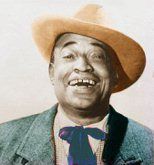

|
|
The face of Tim Moore is known to millions as that of George "Kingfish" Stevens, star of the "Amos 'n Andy" television program. What is not so well known is that Moore was literally called out of retirement to play that role. He enjoyed a wide and varied career for many years prior to his selection to play "The Kingfish." In the popular memory, The Amos 'n Andy television show suffers from the reputation of its radio predecessor. Certainly it featured some stereotypical characters and situations. To allege otherwise would be disingenuous. However, one must ask why "Sanford and Son," "The Jeffersons," and "Good Times" came and went with barely a peep, while "Amos 'n Andy" is recalled with strong emotional hatred in some quarters. 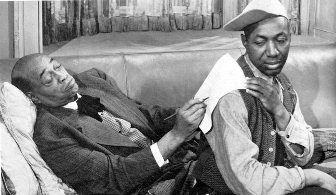
Among the worst of the stereotypes was the custodian "Lightnin'," seen here with Moore as the Kingfish. Like the portrayals by Stepin Fetchit and Willie Best before him, this character, as played by Horace Stewart was unquestionably objectionable. Still, I cannot resist the observation that the "cocked hat" style which was once a sign of dimwittedness is now considered quite fashionable. Go figure. Oh, well. Let's not go too far down that path. The purpose of this page is not to debate the merits of the Amos n' Andy show. Information on that topic, even whole books, is available elsewhere. Our task is to find what we can about the other Tim Moore. THE EARLY YEARS Harry Roscoe "Tim" Moore was born December 9, 1887, the son of Harry and Cynthia Moore. He grew up in Rock Island, Illinois, where he began his show business career as a child shuffling and singing for passersby on the sidewalk. At the age of 12, Moore and colleague Romeo Washburn left Rock Island to join a vaudeville troupe, appearing in an act called "Cora Miskel and Her Gold Dust Twins." Moore soon displayed that he was a young man of many talents and his skills took him as far afield as the British music halls. Returning to the States, young Tim joined Dr. Mick's Puritia company, a medicine show that played vacant lots all over the midwest. Moore began developing his "con-man" persona at an early age, selling a cure-all potion to gullible customers--"We sold two bottles for Dr. Mick and one for us." His varied career, in these early days, even included a stint as a carnival "geek," pretending to "bite off the head of a snake every half hour to satisfy a thirst for snake poison." Apparently, Moore even found his way to Hawaii, where he posed as a native tour guide, taking carloads of tourists around Oahu, manufacturing ancient Hawaiian legends from his imagination. At age 15, he returned to Rock Island and worked as a fly-shooer in a stable and a fight manager, even pursuing success as a horseracing jockey. At 17, Moore turned his attention to pugilistics, reportedly touring the world as a professional boxer named "Young Klondike" and earning $110,000, winning 84 of 104 fights. 
Following his boxing and racing career, Moore developed a one-man version of "Uncle Tom's Cabin." He portrayed both Simon Legree and Uncle Tom, performing with one half his face made up with white chalk and the other with burnt cork. Moore also toured on the black vaudeville circuit, commonly appearing with his wife Gertrude. In the '20s, Moore teamed up with Mantan Moreland, the bug-eyed comic actor who is best remembered today for appearances in a number of Charlie Chan movies. These vaudeville shows, commonly performed in burnt cork, included:
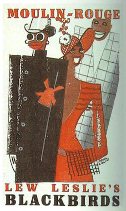
Both Moore and Moreland worked with the Lew Leslie Revue, Blackbirds of 1928. The two men were part of the company that appeared both on Broadway and on tour in Europe. Together with the Berry Brothers, they played the Moulin Rouge in Paris on June 7, 1929, in a show headlined by singer Adelaide Hall, and featuring songs by the popular songwriting team of Jimmy McHugh and Dorothy Fields. Might Moore have been the inspiration for the figure shown in this poster in the checked suit? Speaking of Paris in 1929, I wonder if Moore crossed paths with Mistinguett, "Queen of the French Music Hall," who was moving her base of operations from the Moulin Rouge to the Casino de Paris at that very time. With respect to Blackbirds of 1928, the sketchy information I have indicates that Moore was a featured performer, not just another member of the company. The "poker game" scene was reviewed as "hilarious," and Moore was undoubtedly one of the featured players. He reportedly also appeared in the 1934, 1936 and 1939, version of this same show. Tim Moore appeared in a number of black musical revues over a period of 15 to 20 years. The following information, from "Black Musical Theatre" by Allen Woll (Louisiana State University Press, 1989), relates to three New York City productions: Lucky Sambo, a 1925 effort, premiered during an early June heat wave. Opening night was only sparsely attended, and within ten minutes, some men in the audience removed first their collars and later their shirts. The show, which had traveled on the road (1923-1924) as Aces and Queens, seemed interminable to the critics. ... Although Tim Moore performed valiantly as a con man who discovers an oil well, first-week receipts were low. As a result, the orchestra refused to play without pay, thus closing the show after one week. Blackberries of 1932, which opened in April, attempted to revive the black revues of the 1920s. Despite the similarity in title to the Blackbirds shows, Lew Leslie was not involved with this latest effort, although he did attend on opening night. ... From the opening (a levee number with fleeting clouds against the backdrop) to the Act II finale ("Those Good Old Minstrel Days"), Blackberries failed to supply even the slightest hint of originality. Tim Moore, Mantan Moreland, and Eddie Green offered some humor, but the critics panned the show. The Sun described it as a "nightmare." Harlem Cavalcade, a 1942 production, reunited some of the greats of the early 1920s, Noble Sissle, Flournoy Miller, and Tim Moore, in what most critics dismissed as a second-rate vaudeville show. Co-produced by Ed Sullivan, the show paraded current and past Harlem talents before a supportive audience. While the show maintained the flavor of 1920s vaudeville performances, the writers attempted to update the enterprise for the war effort. Tim Moore and Joe Byrd appeared as air-raid wardens, but were stationed in a cemetery, and Flournoy Miller devoted his malaprop routines to trying to fill out a draft board questionnaire. ... As a result of the harsh reviews, the Cavalcade lasted only forty-nine performances. Tim Moore appeared in other musical comedies, including Fast and Furious (1931), which also featured "Moms" Mabley, Take the Air, in which he was the featured comic, the hit Shuffle Along, Harlem Scandals, and Rhapsody in Black. He also appeared on more than one radio series, a Westinghouse program that ran for 18 weeks, and a Warden Lawes feature in 1934. According to the "Rock Island Argus" newspaper, Moore acted as the top comedian for a number of "name bands" from 1943 to 1946. If someone has more detail about these activities, I would be most grateful to hear from you. Moore wrote nearly all of his own material as well as skits for other performers. Reportedly, one of his sketches, "Not a Fit Night for Man nor Beast," was bought by W.C. Fields, who performed it in a movie. Tim Moore often performed (sometimes in white face) in the British Isles. One of his most popular skits was entitled "A Real Black Scot." THE FILMS The black film industry, like the negro baseball leagues, has been sadly neglected by most researchers and archivists. Consequently, little is known and a great deal of material has been lost in the shuffle. While information regarding Moore's film career is sketchy, I can report to you these few appearances: His Great Chance Darktown Revue 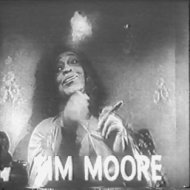
Boy! What a Girl! This rediscovered all-black-cast musical comedy features Tim Moore as a bald, cigar-smoking female impersonator pursued by three men with marriage on their minds. The story revolves around two young would-be show business entrepreneurs who are trying to raise money for their production. Circumstances dictate that Tim Moore pose as a wealthy Parisian businesswoman--Madame Deborah--in order to induce financial assistance from a potential backer. Meanwhile, the real Madame shows up and predictable comedy situations ensue, all interspersed with quite entertaining musical numbers, first at a rent party and later at a more formal gathering on the roof garden. |
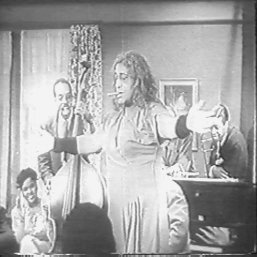
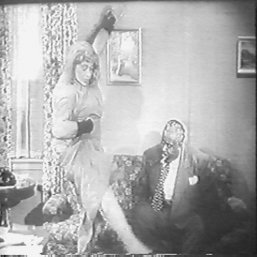
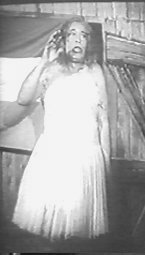
|
This better-than-average-for-its-type production presents a rare opportunity to see Tim Moore as he was prior to the Amos 'n' Andy years. And how is he? Well, his performance is broadly comic in exactly the same way as he played the Kingfish. Indeed, you could just as easily believe that the film was made after, not before, the A&A series. [On the other hand, I can't remember ever seeing Kingfish running from the police in a tutu!] The film is available on video tape, possibly from more than one source. Mine was purchased from Scorched Earth Productions. The print, and portions of the soundtrack, leave something to be desired. On the other hand, we are lucky that this film has survived in any condition. THE MIDDLE YEARS Beginning in January 1950, Moore made some appearances on Ed Sullivan's "Toast of the Town" television program and appeared at the Apollo Theatre in Harlem. Shows like those at the Apollo soon evolved into traveling Rhythm and Blues Revues attended in the mid-'50s by both white and black audiences. Despite Moore's varied career over nearly half a century, the future looked none too bright. By the beginning of the 1950's, he had retired to his native Rock Island, Illinois, "to fish and relax and do both of them real slow." He even took a night job operating a machine at the Servus Rubber Company, a maker of rubber boots and footwear. Little did he know that a phone call was about to be made which would present him with the signature role of his entire show business career. THE AMOS 'N' ANDY SHOW 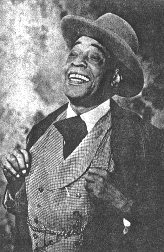 Tim Moore had already been in show business for something like 50 years when he was chosen to play the role of George "Kingfish" Stevens in the television version of the wildly popular "Amos 'n' Andy" radio show. The "Kingfish," head of the Mystic Knights of the Sea lodge, was a lovable scoundrel at his most lovable, a role tailor made for Moore. The television show premiered on June 28, 1951, and ran on CBS for two years, through June 11, 1953, thereafter being available in syndication. According to the A.C. Nielson company ratings, The Amos 'n' Andy Show was the 13th highest rated show during its first year on the air. For that same season the top-rated show was Arthur Godfrey's Talent Scouts. In 1979, your humble scribe had the opportunity to interview Alvin Childress (Amos) and Ernestine Wade (Sapphire) at her home in Los Angeles for about two hours. Some nice photos and a few excerpts from the published interview, directly relating to Tim Moore and "The Kingfish" are available for your perusal. 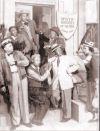
Beyond the remarkable and outrageous performance of Tim Moore, Amos 'n' Andy featured a cast of many other talented black performers, some of whom also had long and varied careers worthy of further study. While such is not within the scope and purpose of this page, I do have for you the best, nearly complete, cast photo that you are ever going to see. Click the little image for a larger view of this fabulous picture. Though often criticized for its racially-based humor, the context of the times in which Amos 'n' Andy was televised is often overlooked. Contemporary shows which also capitalized on ethnic exaggeration or played up the gullibility of its characters included Mama, Life With Luigi and The Life of Riley, all of which were as popular, if not more so, among viewers whose lives closely resembled the characters being portrayed as they were with the general public. But with the long-overdue emergence of the civil rights movement and increased sensitivity to racial and ethnic discrimination, it became no longer acceptable to laugh at stereotypical comedy, even if its creators did not intend the shows to be representative of an entire race or group. Whatever else, there is simply no denying that Moore's portrayal of the "Kingfish" was brilliant. Sammy Davis, Jr. is quoted in an Ebony magazine article as saying: He had the unique ability in comedy to vault a lot of the build up in a funny situation with a facial expression or a gesture that told more than a hundred words in the mouth of another comedian. For a bit of historical perspective, you may wish to see the text from an NAACP bulletin released just six weeks following the premiere of The Amos 'n' Andy Show. In early 1966, the CBS Films division of the Columbia Broadcasting System withdrew Amos 'n' Andy from television syndication, saying that the show was "outdated." After nearly 40 years on radio and television, a show applauded by some and damned by others had come to the end of the road. Six years later, on January 14, 1972, Sanford and Son premiered on NBC and quickly became the 6th highest rated show of the season.
THE LATER YEARS  Late in his career, Moore is reported to have served as a master of ceremonies at a Los Angeles nightclub, but I have no further details. Over the years, Tim Moore was married four times, to: Hester, Gertrude (his vaudeville companion "Gertie"), Benzonia Davis (1889-1956), and Vivian Moore (1912-1988). In early 1958, having remarried after the death of his third wife, Tim Moore popped up in the headlines when he was arrested, jailed and convicted on a misdemeanor charge and fined $100 for firing a pistol during a domestic dispute over a beef roast that had disappeared from his refrigerator. Complaining that his wife's free-loading relatives had eaten the meat, he had lost his temper and gone upstairs for his gun. Newspapers played the incident for all it was worth, crafting such headlines as: Police Hook Kingfish for Beef Over Roast. "I'm the old Kingfish," Moore reportedly told the police when they reached the premises. "You should have seen the in-laws scatter when I fired that gun." Following this brouhaha, Tim Moore appeared at least twice with Jack Paar on the old Tonight Show. Audio tapes of these two appearances are known to exist. Within less than a year, Moore was dead, a victim of pulmonary tuberculosis. At his funeral, according to Variety, the church overflowed with "thousands of his friends and fans." Freeman Gosden and Charles Correll (creators of the Amos 'n' Andy radio characters) were honorary pallbearers, but it was Moore's black colleagues, including Alvin Childress ("Amos"), Spencer Williams, Jr. ("Andy"), and Johnny Lee ("Algonquin J. Calhoun"), who carried his remains to their final destination. LINKS 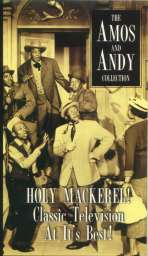
"Where can I buy Amos n' Andy video tapes?"
Amos n' Andy fans may also want to take a look at The Original Amos 'N' Andy Web Page, a comprehensive and informative site which also includes links to other "Amos 'n' Andy" pages. Fans of "Amos n' Andy" may also be interested in the collection of links found in the classic TV portion of the comprehensive About.com site. As a little bonus, we all know that The Amos 'n' Andy Show was filmed and broadcast in black and white. But suppose Ted Turner had gotten ahold of the series and colorized it? BIBLIOGRAPHY I am indebted to Barry Moreno, whose late grandmother, Vivian Moore, was Tim Moore's widow, for several important additions and corrections to this page. In addition, three very excellent books which have served as the source of a portion of the biographical information on this page deserve your further attention:
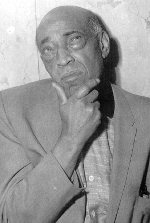
Hmmmmm? I wonder if there is someone out there who has more information about the career of this wonderful performer. If so, I would certainly appreciate his or her sharing it with me. |
|
Just click one of these icons and bookmark or make a favorite of the page it takes you to. Thereafter, your purchases from Amazon will produce a small credit to yours truly. The eBay icon takes you to a list of items that my alter ego, Otto, is offering at auction this week. Donations Are Welcome If you are one of those rare angels who would like to make a modest donation to support my efforts, you may do so by clicking the Pay Pal "Donate" image and filling in the pertinent information that will appear on the next screen. It's fast and easy and your surprising generosity will be greatly appreciated. MORE? Many other areas of the "Popular Culture Excavation Site" await you. Full descriptions are on the main menu or go directly to the area of your choice by clicking one of these seductive little images.Return to the main menu.
This page created and maintained by Jim Lowe First appearance: May 18, 1997 Last updated: February 15, 2000 |